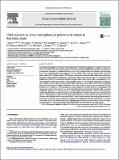Por favor, use este identificador para citar o enlazar a este item:
http://hdl.handle.net/10261/218163COMPARTIR / EXPORTAR:
 SHARE SHARE
 CORE
BASE CORE
BASE
|
|
| Visualizar otros formatos: MARC | Dublin Core | RDF | ORE | MODS | METS | DIDL | DATACITE | |

| Título: | Child exposure to indoor and outdoor air pollutants in schools in Barcelona, Spain |
Autor: | Rivas, Ioar; Viana, Mar CSIC ORCID ; Moreno, Teresa CSIC ORCID ; Pandolfi, Marco CSIC ORCID; Amato, Fulvio CSIC ORCID ; Reche, Cristina CSIC ORCID; Bouso, L.; Álvarez-Pedrerol, Mar; Alastuey, Andrés CSIC ORCID; Sunyer, J.; Querol, Xavier CSIC ORCID | Fecha de publicación: | 2014 | Citación: | Environment International 69: 200- 212 (2014) | Resumen: | Proximity to road traffic involves higher health risks because of atmospheric pollutants. In addition to outdoor air, indoor air quality contributes to overall exposure. In the framework of the BREATHE study, indoor and outdoor air pollution was assessed in 39 schools in Barcelona. The study quantifies indoor and outdoor air quality during school hours of the BREATHE schools. High levels of fine particles (PM2.5), nitrogen dioxide (NO2), equivalent black carbon (EBC), ultrafine particle (UFP) number concentration and road traffic related trace metals were detected in school playgrounds and indoor environments. PM2.5 almost doubled (factor of 1.7) the usual urban background (UB) levels reported for Barcelona owing to high school-sourced PM2.5 contributions: [1] an indoor-generated source characterised mainly by organic carbon (OC) from organic textile fibres, cooking and other organic emissions, and by calcium and strontium (chalk dust) and [2] mineral elements from sand-filled playgrounds, detected both indoors and outdoors. The levels of mineral elements are unusually high in PM2.5 because of the breakdown of mineral particles during playground activities. Moreover, anthropogenic PM components (such as OC and arsenic) are dry/wet deposited in this mineral matter. Therefore, PM2.5 cannot be considered a good tracer of traffic emissions in schools despite being influenced by them. On the other hand, outdoor NO2, EBC, UFP, and antimony appear to be good indicators of traffic emissions. The concentrations of NO2 are 1.2 times higher at schools than UB, suggesting the proximity of some schools to road traffic. Indoor levels of these traffic-sourced pollutants are very similar to those detected outdoors, indicating easy penetration of atmospheric pollutants. Spatial variation shows higher levels of EBC, NO2, UFP and, partially, PM2.5 in schools in the centre than in the outskirts of Barcelona, highlighting the influence of traffic emissions. Mean child exposure to pollutants in schools in Barcelona attains intermediate levels between UB and traffic stations. © 2014. | Versión del editor: | http://dx.doi.org/10.1016/j.envint.2014.04.009 | URI: | http://hdl.handle.net/10261/218163 | DOI: | 10.1016/j.envint.2014.04.009 | Identificadores: | doi: 10.1016/j.envint.2014.04.009 issn: 1873-6750 |
| Aparece en las colecciones: | (IDAEA) Artículos |
Ficheros en este ítem:
| Fichero | Descripción | Tamaño | Formato | |
|---|---|---|---|---|
| 1-s2.0-S0160412014001202-main.pdf | 2,17 MB | Adobe PDF |  Visualizar/Abrir |
CORE Recommender
SCOPUSTM
Citations
243
checked on 03-abr-2024
WEB OF SCIENCETM
Citations
222
checked on 25-feb-2024
Page view(s)
154
checked on 18-abr-2024
Download(s)
172
checked on 18-abr-2024
Google ScholarTM
Check
Altmetric
Altmetric
NOTA: Los ítems de Digital.CSIC están protegidos por copyright, con todos los derechos reservados, a menos que se indique lo contrario.
